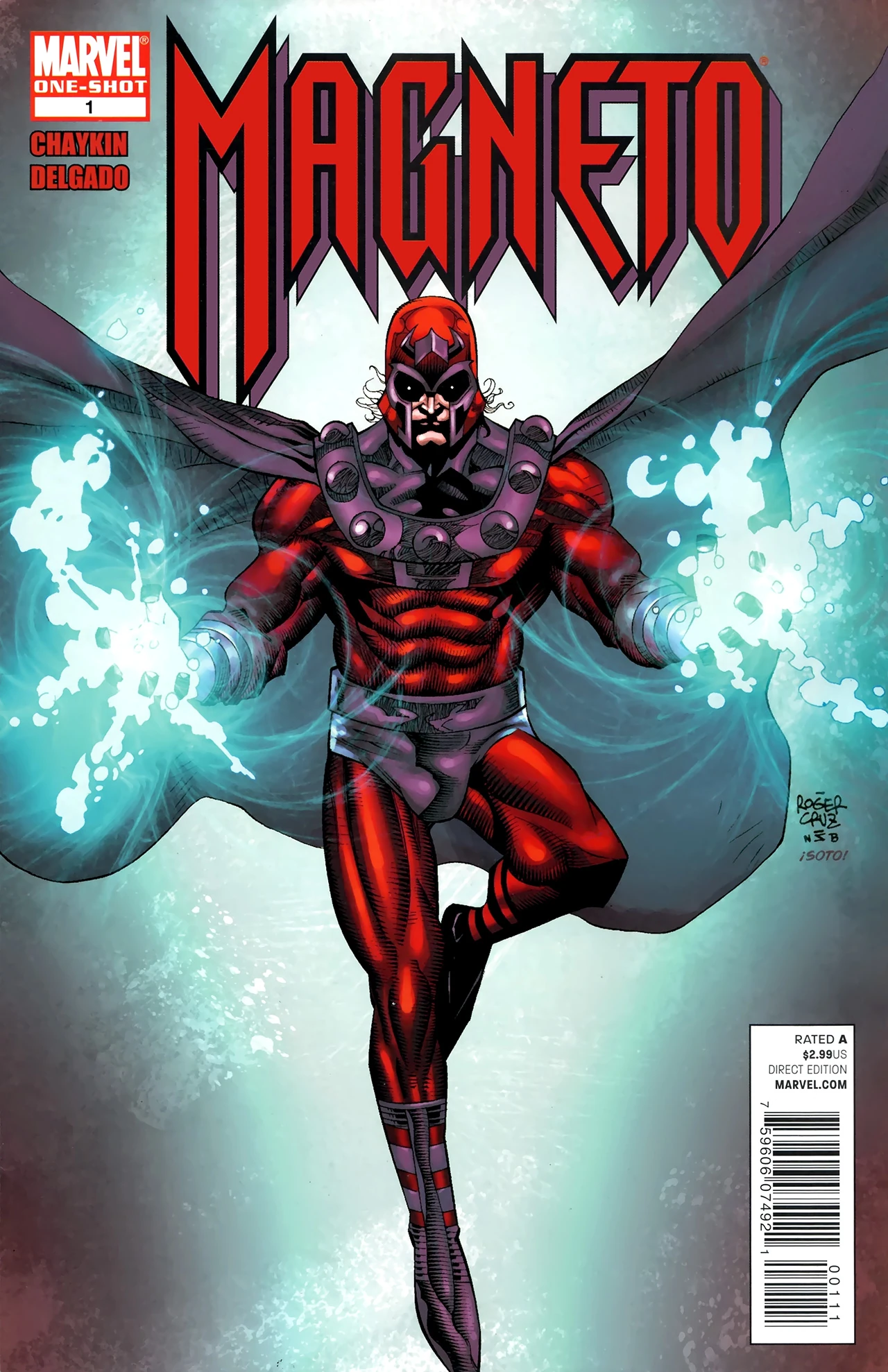
The sinister Dr. Doom often fights the entire Fantastic Four in battles that the quartet seemingly cannot win. Nearly every hero in the Marvel universe fought Thanos, the rogue titan, in the world-shaking Infinity Gauntlet. The Dark Phoenix possessed the power to destroy galaxies when she struggled against her fellow X-Men. Still, it’s rare that a villain is so powerful that he can’t be defeated by a single superhero but needs the combined efforts of a team to do the job.
In the realm of the X-Men, there are a number of incredibly devastating villains. Powerful X-Men foes have included the already mentioned Dark Phoenix, Erik the Red, Holocaust, Apocalypse, Mr. Sinister, the Goblin Queen, Typhoid Mary, the Shadow King, and many others. But the most dangerous villain of all is the man called Magneto.
Magneto makes his first appearance in the initial issue of X-Men (#1, September 1963). Dressed in a red and purple uniform and a bizarre helmet complete with metal horns, he refers to himself as Magneto, Master of Magnetism. As with many supervillains, he enjoys talking to himself—not one of the best indications of sanity. He also has the bad habit of referring to himself in the third person— a sure sign of an overwhelming ego.
Magneto strikes the army base at Cape Citadel, where NASA is testing its first rocket ships. Using his magnetic power, Magneto causes six launches to crash. It gives him great pleasure, demonstrating he can stop the space program in its tracks.
Yet he doesn’t claim credit for the sabotage, negating any publicity he might get for his actions. In these early X-Men adventures, pace dictates the story details instead of logic. After the last crash, in an attempt to startle and confuse the troops at the base, Magneto uses magnetized dust particles to spell out a huge skywriting warning: surrender the base or
i’ll take it by force!—magneto.
The base personnel are suitably shocked, but they don’t surrender the base. Skywriting might be an impressive trick, but it’s not very frightening. Magneto, however, seems surprised that the troops don’t run screaming in fear from their posts.
To make his point, he sets off one of the base’s guided missiles to destroy some nearby deserted ships (killing innocent civilians in the early years of Marvel Comics was taboo). The soldiers still refuse to budge, which really annoys Magneto. Dressed in his red and purple uniform, he finally walks up to the base itself, wraps up the troops in hardened magnetic waves, and puts a magnetic force field around Cape Citadel.
The army surrounds Cape Citadel but can’t break through the magnetic barrier. Magneto isn’t prepared to battle mutants, and the X-Men use their special powers to smash through the shield. After several minor skirmishes, Magneto decides the base isn’t worth the effort and uses his magnetic repulsion power to fly away. The X-Men have won the first battle, but the war is far from over. Magneto never once mentions the reason he wanted to capture Cape Citadel or what he would have done if he had been able to keep it under his control.
Among his worst faults as a supervillain, Magneto rarely plans very far in advance, and he doesn’t believe in backup strategies. Magneto returns a few issues later to battle the X-Men again, but in this adventure he brings friends. Magneto’s assistants have no group name, but Marvel likes to refer to them collectively as the Band of Evil Mutants (later known as the Brotherhood of Evil Mutants).
Among Magneto’s earliest recruits are the Mastermind, Toad, the Scarlet Witch, Quicksilver, and from time to time, the Blob. Though the odds are evened up, the Evil Mutants are never able to beat the X-Men, partly because the good guys fight together as a team while the evil mutants fight as selfish individuals.
Can a person control magnetism just by using his or her mind? As pointed out in our previous book about comics, The Science of Superheroes, there’s no widely accepted scientific explanation for human extrasensory perception (ESP).
There’s no thoroughly documented proof that it actually exists. However, there’s definitely a link between magnetism and the brain. A human brain has billions of neurons that discharge electricity whenever stimulated. These electrical patterns are called brain waves, which are affected by magnetism in ways that cannot be fully explained.
For example, according to a series of tests performed at the Centre for the Mind in Sydney, Australia, magnetic waves improved the drawing skill level of seventeen volunteer children in less than fifteen minutes. Professor Allan Snyder, who runs the Centre for the Mind, uses a Medtronic machine to supply electromagnetic pulses that he claims can give extraordinary skills to ordinary people. Snyder believes that people gain “isolated pockets of geniuslike mental ability” after exposure to transcranial magnetic stimulation.
Despite all the hype and talk about EMP bombs and EMP weapons, there’s been no actual demonstration of an EMP wave being created without an atomic explosion. All of the dire warnings from defense contractors, Internet diagrams, and $400 bomb kits have proven empty. Electromagnetic pulse weapons may be the weapons of the future, but so far they’re only seen in comic books. They are the stuff of Magneto. Hopefully, they’ll remain that way.
No comments:
Post a Comment